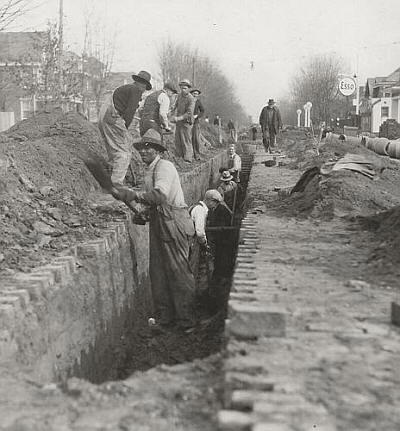
CWA Projects
------------------------------------------------------------------------------------------------------

One of the most important Civil Works Administration (CWA)
projects in the Huntington area was the construction of
new sewers on the city’s south side, from
14th Street to West 5th Street.
File photo | The Herald-Dispatch
------------------------------------------------------------------------------------------------------
HUNTINGTON — With the
arrival of the Great Depression in 1929,
millions of workers lost their jobs, almost overnight. When Franklin D.
Roosevelt took office as president in 1933, he quickly launched
a series of programs aimed at stabilizing the economy
and putting jobless Americans back to work.
One of those programs was the Civil Works
Administration (CWA),
which in less than five months — from November 1933 to March
1934 — provided jobs for 4 million people. Nationwide,
CWA workers laid 12 million feet of sewer pipe and
built or improved 250,000 miles of roads, 40,000
schools, 3,700 playgrounds and
nearly 1,000 airports.
In the Huntington area, the CWA program
employed 4,000
men on sewer and road improvements and work at Ritter
Park, Marshall College (now University), Spring Hill
Cemetery and the Huntington State Hospital.
One of the most important CWA projects was
the construction
of new sewers on the city’s south side, from 14th Street to
West 5th Street. And CWA workers labored
alongside State Road Commission crews
to improve 5th Street Road, helping
speed traffic between Huntington
and Wayne.
CWA workers erected a new stone wall
around Ritter Park’s
popular rose garden, along with a new brick wall and
sidewalks on the Marshall campus. A quarry was
opened at Spring Hill Cemetery to provide stones
for a decorative fence around the cemetery.
More than $120,000 was spent on
improvements to the buildings and
grounds at the State Hospital.
Although the CWA provided much employment,
there were
critics who said there was nothing of permanent value.
Such criticism prompted Roosevelt to end the CWA
and replace it with the Work Progress Administration
(WPA), which would emphasize projects with
long-term value in addition to short-term
benefits for the unemployed.
-----------------------------------------------------------
Note: This Article and picture appeared in the Herald-Dispatch Newspaper on Sep. 27, 2022..
-----------------------------------------------------------
[ Back ]